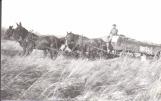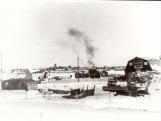1
St. Francois settlement and parish at J. Landels farm site, Mile 16.1915
Carrot Valley, Manitoba
 Credits:
Credits:D.F. de Tremaudan
PP86.12.1
2
The first crop was seeded in the Carrot Valley in the spring of 1754 by Captain Louis De La Corne St. Luc - almost 60 years before the founding of the Red River Settlement near present day Winnipeg in 1812. It was not until the twentieth century, however, that agriculture would become truly feasible in the Carrot River Valley west of The Pas.In 1915 a group of French Canadian settlers moved to the Carrot Valley to establish a farming community. The venture was short lived when a flood in 1916 forced them to evacuate their farms. In response to the disastrous flooding, the federal government restricted settlement to the lots on the south bank of the Carrot River.
3
Steamboat alongside a scow that is loaded with supplies and cattle for the Carrot River Valley.1 July 1915
The Pas, Manitoba
 Credits:
Credits:PP2000.6.36
4
The problem flooding of the Carrot Valley was always known, but the agricultural possibilities of the region lured the interest of settlers and government agricultural consultants alike. The first enthusiastic advocate for reclaiming the Pasquia region was William Ogilvie. He reported in 1911 that "the soil along the Carrot above the low lands is of finest quality."Investigations into reclamation of the Pasquia region continued off and on through out the next several decades, but although there was interest, the 1924 report summed up the reluctance to sink funds into an extensive project: "The area...has great potential agricultural possibilities but the advisability of its construction is largely dependent in the needs for more farmland in the West, for which, at the present time, there is little demand."
6
Olga, Marie, and Emilia Baran by their family vegetable garden on Crossley Avenue.c. 1925
The Pas, Manitoba
 Credits:
Credits:PP2001.4.1
8
Jesse Vennase hauling supplies in a horse-drawn cartc. 1920
The Pas, Manitoba
 Credits:
Credits:Foster, S.
PP2000.5.95
12
The Pas Dairy Sleigh and an unidentified man.20th Century
The Pas, Manitoba
 Credits:
Credits:Henry Buchberger
PP93.18.312a





